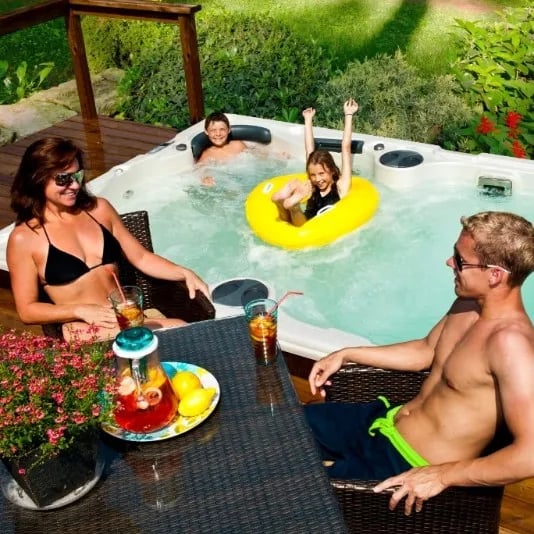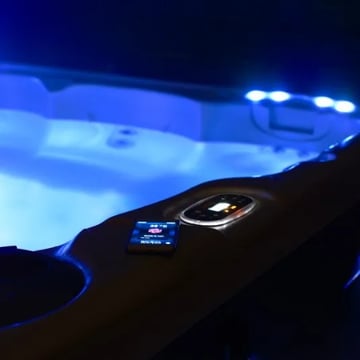Why Choose a Hydropool Hot Tub?
1) Self-cleaning system
Why Choose a Hydropool Hot Tub? The Hydropool Self-Cleaning system cleans 100% of the water every 15 minutes, using a range of technologies which work together to keep your hands-on hot tub maintenance to a minimum.
- The triangular floor vacuum removes settling sediment.
- The high flow skimmer & pre-filter cleans across the surface of the water.
- Pressurised micro-filtration with removable easy-clean core filter.
- Especially designed filtration jets, strategically placed to direct floating debris towards the high flow skimmer.
- Optional Ozone and UV combines to eliminate 99% of contaminants and works to prevent calcium and Biofilm from building up inside pipework. This feature reduces chemical usage by 50%,
- The dosing in-line feeder makes easy work of chlorine management and other water treatments.
Learn more about Hydropool Self-Cleaning technology
2) Designed, innovated and made in Canada
Established in Mississauga, Canada in 1980, Hydropool is recognised worldwide for excellence and innovation in the hot tub and swim spa industry.
- Designed alongside professional athletes and physiotherapists to provide real hydrotherapy and beneficial massage.
- Built in our dedicated Canadian factory to industry-leading standards.
- Engineered to retain heat and withstand extreme arctic temperatures.
- Number one brand of choice for professional sports teams such as The Toronto Maple Leafs and New York Rangers.
- Hydropool hot tubs and swim spas are installed in over 60 countries worldwide.
- Hydropool are committed to minimising and neutralising the carbon emissions through lean manufacturing processes.

3) Maximum efficiency insulation
- For minimal impact on your electricity bill, Hydropool hot tubs have been engineered for energy efficiency and locking heat in
- Pipework is wrapped in heavy-duty plastic wrap, which supports the pipework and creates insulating air pockets
- The inner shell and cabinet is insulated with triple-pane, silver-backed Thermal Shield blanket, similar to the material used by N.A.S.A in their space suits
- Waste heat from the pumps and heater is captured and redirected back into the hot tub
- Heavy-duty, lockable hard cover is 4″ thick in the middle and tapers to 3″ at the edges to allow rain run-off. Fold areas are made with insulated baffle for locking heat in
- The cabinet has vents to open on hot summer days to let out excess heat (yes, they’re that well-insulated!)
4) Advanced pressurised filtration
Water is pushed through the filter under pressure. This ensures the whole of the filter is used, unlike a gravity fed filter. It takes only 15 minutes to clean 100% of the water.
The two-stage filter features a Microban outer mesh with a fine inner core, which will filter down to 5 microns – the size of a white blood cell!
5) Jets and high flow-rate pumps
- Multiple types of jet, easily interchangeable to suit each user.
- Get deep tissue massage to work different muscle groups with our Hydrotherapy Wellness Programs – timed sequences of jet patterns innovated to aid:
– Leg pain
– Back pain
– Sports recovery
– Headaches
– Insomnia
– Stress
– Diet boost
– Full body awakening
Wellness Programs, at the touch of a button, are a standard feature on our Self-Cleaning Platinum models.

In hot tubs, pumps should be designed to be low horsepower with high flow rate. This means the pumps are properly rated for the jets, they pump a high volume of water and remain energy efficient.
- In a Hydropool hot tub, the pumps and jets have been designed as one system. The number, style, and power of the jets is correct for the pumps.
- Hydropool low amperage Evergreen pumps are engineered to produce high flow rates with low energy output.
- Many other hot tub brands have an arbitrary number of jets and pumps to inflate their specification.
- The maximum rating of any hot tub pump is 4 horsepower as it is impossible to run anything bigger on a home electrical panel.
- American horsepower ratings are different to european ratings.
- Water flow control is more important than horsepower ratings.
- Oversized horsepower pumps raise your electric bill.
- There is no set standard for rating horsepower in the hot tub industry.
- Look for strong water jets with high gallon-per-minute rating and a lower horsepower rating.
- The test is to physically feel the power of the water jets and compare it to the gallons per minute ratings and the horsepower ratings.
- When researching hot tubs, you may come across “market rating” or an “uprating”. These ratings only measure the horsepower during start-up, not continuous running.

6) Choice
With the range of options Hydropool offer, you can practically build-your-own hot tub to suit your requirements.
- Choose your model – size with seat and lounger configuration.
- Choose your exterior cabinet colour
- Choose your interior shell colour
- Choose your package options – additional features such as:
– HydroFlex heated air massage therapy
– Cascading HydroFall pillow jets
– Northern Lights LED lighting
– DreamScents aromatherapy essential oils and in-feed release system.

7) Easy maintenance
- Panels are attached magnetically for ease of access inside the cabinet. No screwdriver required.
- Easy-drain system using shut off valve, built in drain pipe, and floor vacuum system – there’s no need for an external sump pump to drain.
- Our self-cleaning technologies work hard for you, meaning less frequent drain down compared with other hot tubs on the market.
Visit our sister company Cabin Master to find out how they can create your perfect Hot Tub enclosure
FREQUENTLY ASKED QUESTIONS
How much does it cost to replace a hot tub pump?
The cost to replace a hot tub pump can vary based on several factors, including the type of pump, the model of the hot tub, and labour costs. Generally:
- Pump Cost: Replacement pumps typically range from £200 to £600. The price can depend on the pump's brand, horsepower, and whether it's a single or dual-speed pump.
- Labour Cost: If you hire a professional for installation, labour costs can range from £100 to £250, depending on the complexity of the job and local rates.
Overall, including both parts and labour, you might expect to pay between £300 and £850 for a complete replacement.
How long do hot tub pumps last?
Hot tub pumps generally last between 5 to 10 years, depending on factors such as:
- Usage: Frequent use can lead to faster wear and tear.
- Maintenance: Regular maintenance and proper care can extend the lifespan of the pump.
- Water Quality: Poor water chemistry can affect the pump's longevity, so maintaining balanced water chemistry is crucial.
Regularly checking and maintaining your hot tub pump can help ensure it operates efficiently throughout its lifespan.
How do I know if my hot tub pump is broken?
Signs that your hot tub pump may be broken or malfunctioning include:
- No Water Flow: If you notice a lack of water flow or pressure from the jets, the pump might not be working properly.
- Unusual Noises: Grinding, squealing, or other unusual noises coming from the pump can indicate mechanical issues.
- Leaking: Water leaking around the pump area can suggest a problem with the pump seals or connections.
- Error Messages: Many modern hot tubs have control panels that display error codes related to pump issues.
- Overheating: If the pump is running excessively hot, it may be failing or experiencing issues.
If you suspect a problem, it's best to consult a professional to diagnose and repair the issue.
Can you change a hot tub pump without draining water?
Replacing a hot tub pump typically requires draining the water from the hot tub. This is necessary for several reasons:
- Access: Draining the water allows access to the pump for removal and installation.
- Prevention of Spills: Working with the pump while the hot tub is full could lead to water spills and complications.
- Safety: It’s safer to perform repairs with the hot tub emptied to avoid electrical hazards and ensure proper handling of components.
In some cases, a professional may use specific techniques to minimise water loss, but generally, draining the hot tub is the standard procedure for pump replacement.

